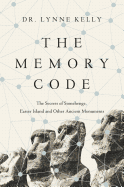
The standing boulders at Stonehenge, the giant head sculptures on Easter Island, the Nazca lines drawn in the Peruvian desert and many other monuments left behind by ancient cultures have intrigued researchers for centuries. In The Memory Code, science writer Lynne Kelly gives readers a new and plausible reason for their existence.
Created by people who had no written language, these sites, Kelly proposes, were used as memory aids to help cultures remember the information they needed for survival, like landscape details that would lead them to food and water, and the healing properties of plants. They were also used to record traditions, myths and ceremonies. Kelly's idea is not farfetched when one considers how indigenous Australians still use songlines to keep track of pathways; Africans have lukasa, or memory boards, covered in beads that represent multiple levels of information; and Native Americans keep records using birchbark scrolls covered with intricate designs.
Kelly not only analyzes a variety of techniques used by indigenous people, but also implements the ideas in her own life. Using her own memory boards, carved sticks and walking routes, she's memorized vast details in geological history, a field guide of state birds, the lineage of royalty in Europe and China, and an array of other details. Readers can readily implement her ideas and train themselves to use these mnemonic devices just as the ancient ones may have done so long ago. --Lee E. Cart, freelance writer and book reviewer

